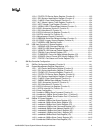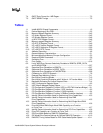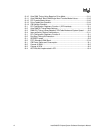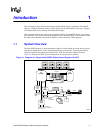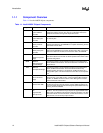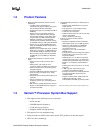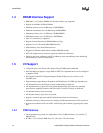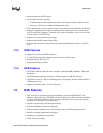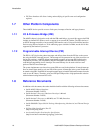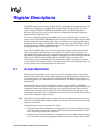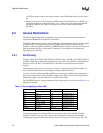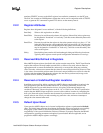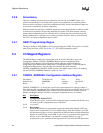
Intel® 460GX Chipset Software Developer’s Manual 1-5
Introduction
• Parity protection on all PCI signals.
• Data collection & write assembly.
— Combines back-to-back sequential processor-to-PCI memory writes to PCI burst writes.
— Processor to PCI write assembly of full/partial line writes.
• Two outbound read requests containing a total of two cache lines of read data for each PCI bus.
• Supports six outbound write requests containing a total of three cache lines of write data for
each 32 bit PCI bus. Supports 12 outbound write requests containing a total of six cache lines
of write data for a 64 bit PCI bus.
• Supports two delayed inbound read requests.
• Supports the I/O and Firmware Bridge (IFB).
• Supports either internal or external arbitration, allowing additional bus masters, on the PCI
bus.
1.5.2 WXB Features
• Support for two 64 bit, 66 MHz PCI busses.
• 3.3 Volt PCI bus operation (supports Universal and 3.3 Volt PCI cards).
• PCI Specification, Revision 2.2.
• Integrated Hot-Plug controller.
1.5.3 GXB Features
• The GXB is AGP and AGP 4X mode compatible, nominal 66 MHz, 266 MHz, 1 GB/s peak
bandwidth.
• The GXB supports pipelined operation or sideband signals on AGP 4X mode bus.
• AGP address space of 1 GB or 256 MB supported. Also supports 32 GB of GART window, if
4 MB pages are used.
• Supports Fast Writes and 1x, 2x and 4x data rates.
1.6 RAS Features
• ECC coverage of system data bus using the Itanium™ processor SEC/DED ECC code.
Memory is protected using a SEC/DED code which also provides nibble detection capabilities
of 4 bits. All control and address signals are parity protected. Local control buses are parity
protected. The Expander is covered by parity.
• Data flows protected by parity throughout chipset.
• ECC bits in DRAM accessible by diagnostics.
• Fault recording of multiple errors; sticky through reset, but NOT through power-down.
• Memory scrubbing implemented in hardware.
• Boundary test capability through JTAG.
• JTAG TAP port for debug.



